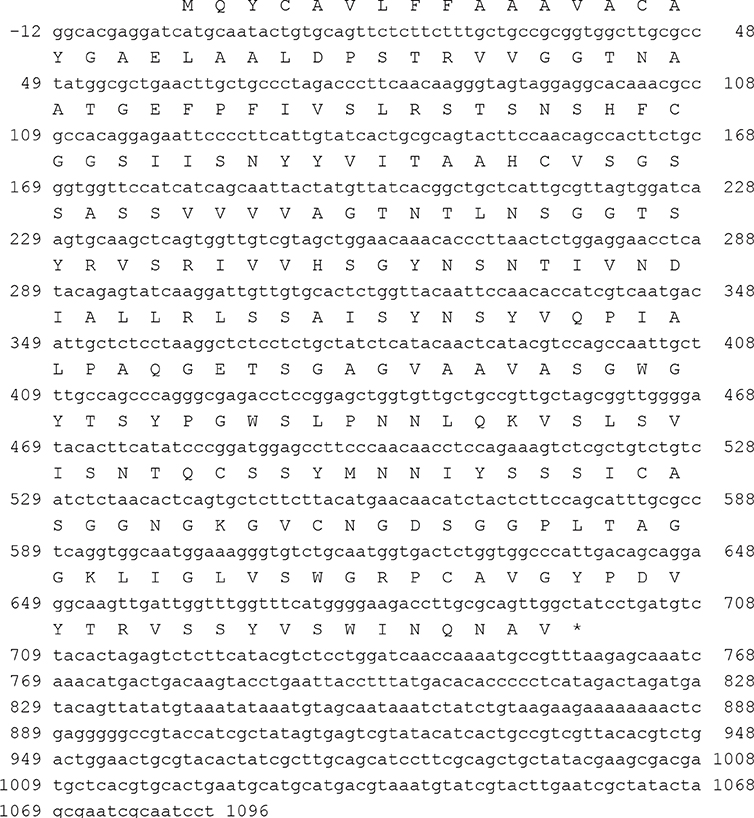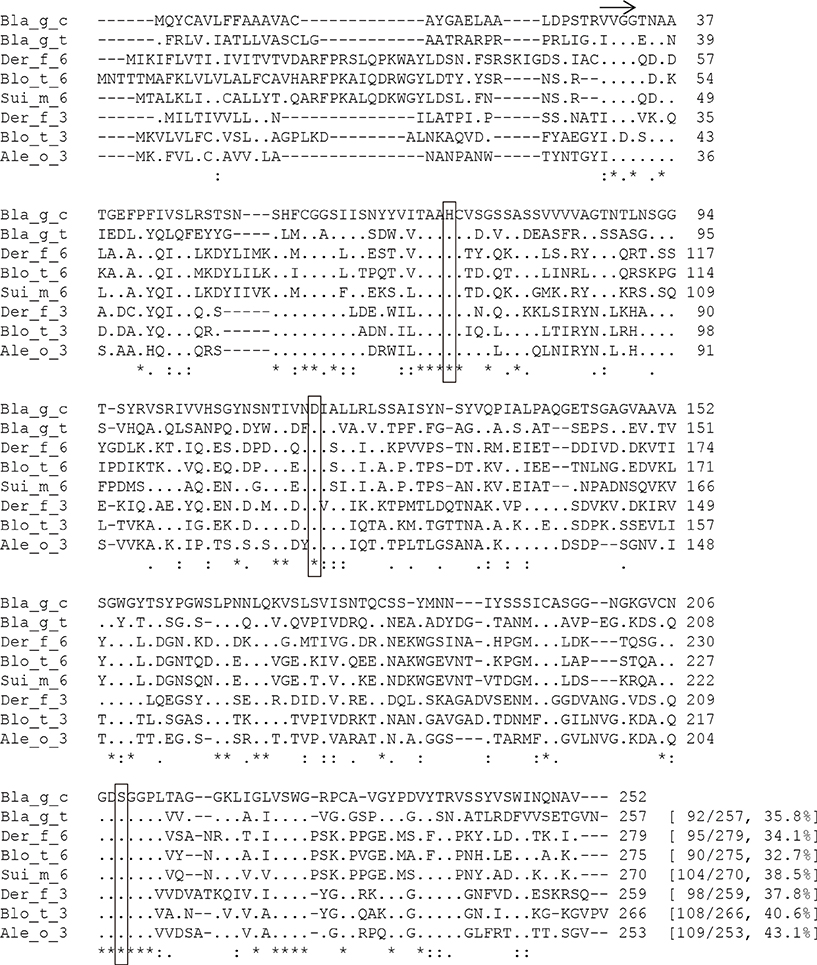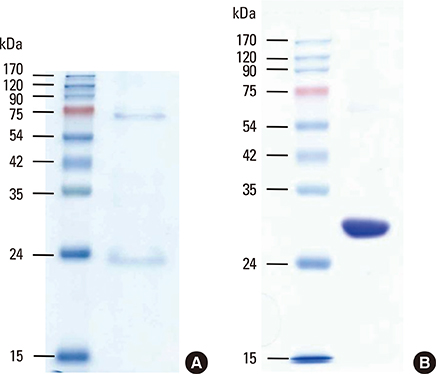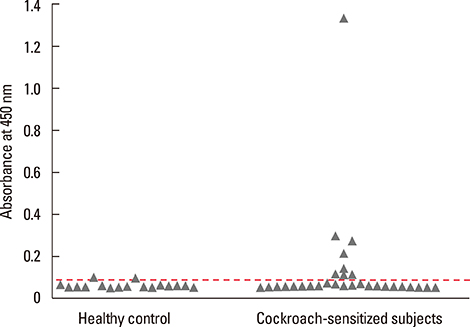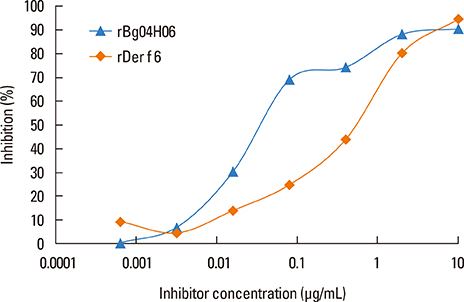Allergy Asthma Immunol Res.
2015 May;7(3):283-289. 10.4168/aair.2015.7.3.283.
Allergenic Characterization of a Novel Allergen, Homologous to Chymotrypsin, from German Cockroach
- Affiliations
-
- 1Department of Internal Medicine, Institute of Allergy, Yonsei University College of Medicine, Seoul, Korea. parkjw@yuhs.ac
- KMID: 2260466
- DOI: http://doi.org/10.4168/aair.2015.7.3.283
Abstract
- PURPOSE
Cockroach feces are known to be rich in IgE-reactive components. Various protease allergens were identified by proteomic analysis of German cockroach fecal extract in a previous study. In this study, we characterized a novel allergen, a chymotrypsin-like serine protease.
METHODS
A cDNA sequence homologous to chymotrypsin was obtained by analysis of German cockroach expressed sequence tag (EST) clones. The recombinant chymotrypsins from the German cockroach and house dust mite (Der f 6) were expressed in Escherichia coli using the pEXP5NT/TOPO vector system, and their allergenicity was investigated by ELISA.
RESULTS
The deduced amino acid sequence of German cockroach chymotrypsin showed 32.7 to 43.1% identity with mite group 3 (trypsin) and group 6 (chymotrypsin) allergens. Sera from 8 of 28 German cockroach allergy subjects (28.6%) showed IgE binding to the recombinant protein. IgE binding to the recombinant cockroach chymotrypsin was inhibited by house dust mite chymotrypsin Der f 6, while it minimally inhibited the German cockroach whole body extract.
CONCLUSIONS
A novel allergen homologous to chymotrypsin was identified from the German cockroach and was cross-reactive with Der f 6.
Keyword
MeSH Terms
-
Allergens
Amino Acid Sequence
Blattellidae*
Chymotrypsin*
Clone Cells
Cockroaches
DNA, Complementary
Enzyme-Linked Immunosorbent Assay
Escherichia coli
Expressed Sequence Tags
Feces
Hypersensitivity
Immunoglobulin E
Mites
Pyroglyphidae
Sequence Homology
Serine Proteases
Allergens
Chymotrypsin
DNA, Complementary
Immunoglobulin E
Serine Proteases
Figure
Cited by 1 articles
-
Physical and biochemical characteristics of allergens
Kyoung Yong Jeong
Allergy Asthma Respir Dis. 2016;4(3):157-166. doi: 10.4168/aard.2016.4.3.157.
Reference
-
1. Matsumura Y. Role of allergen source-derived proteases in sensitization via airway epithelial cells. J Allergy (Cairo). 2012; 2012:903659.2. Bhat RK, Page K, Tan A, Hershenson MB. German cockroach extract increases bronchial epithelial cell interleukin-8 expression. Clin Exp Allergy. 2003; 33:35–42.3. Jeong KY, Kim CR, Park J, Han IS, Park JW, Yong TS. Identification of novel allergenic components from German cockroach fecal extract by a proteomic approach. Int Arch Allergy Immunol. 2013; 161:315–324.4. Robinson BW, Venaille TJ, Mendis AH, McAleer R. Allergens as proteases: an Aspergillus fumigatus proteinase directly induces human epithelial cell detachment. J Allergy Clin Immunol. 1990; 86:726–731.5. Stewart GA, Lake FR, Thompson PJ. Faecally derived hydrolytic enzymes from Dermatophagoides pteronyssinus: physicochemical characterisation of potential allergens. Int Arch Allergy Appl Immunol. 1991; 95:248–256.6. Stewart GA, Bird CH, Krska KD, Colloff MJ, Thompson PJ. A comparative study of allergenic and potentially allergenic enzymes from Dermatophagoides pteronyssinus, D. farinae and Euroglyphus maynei. Exp Appl Acarol. 1992; 16:165–180.7. Yasueda H, Mita H, Akiyama K, Shida T, Ando T, Sugiyama S, et al. Allergens from Dermatophagoides mites with chymotryptic activity. Clin Exp Allergy. 1993; 23:384–390.8. Stewart GA, Kollinger MR, King CM, Thompson PJ. A comparative study of three serine proteases from Dermatophagoides pteronyssinus and D. farinae. Allergy. 1994; 49:553–560.9. Bennett BJ, Thomas WR. Cloning and sequencing of the group 6 allergen of Dermatophagoides pteronyssinus. Clin Exp Allergy. 1996; 26:1150–1154.10. Kawamoto S, Mizuguchi Y, Morimoto K, Aki T, Shigeta S, Yasueda H, et al. Cloning and expression of Der f 6, a serine protease allergen from the house dust mite, Dermatophagoides farinae. Biochim Biophys Acta. 1999; 1454:201–207.11. Jeong KY, Kim C, Yong TS. Enzymatic activities of allergen extracts from three species of dust mites and cockroaches commonly found in Korean home. Korean J Parasitol. 2010; 48:151–155.12. Goodman RE. Practical and predictive bioinformatics methods for the identification of potentially cross-reactive protein matches. Mol Nutr Food Res. 2006; 50:655–660.13. Stadler MB, Stadler BM. Allergenicity prediction by protein sequence. FASEB J. 2003; 17:1141–1143.14. Fiers MW, Kleter GA, Nijland H, Peijnenburg AA, Nap JP, van Ham RC. Allermatch, a webtool for the prediction of potential allergenicity according to current FAO/WHO Codex alimentarius guidelines. BMC Bioinformatics. 2004; 5:133.15. Zhang ZH, Koh JL, Zhang GL, Choo KH, Tammi MT, Tong JC. AllerTool: a web server for predicting allergenicity and allergic cross-reactivity in proteins. Bioinformatics. 2007; 23:504–506.16. Wang J, Yu Y, Zhao Y, Zhang D, Li J. Evaluation and integration of existing methods for computational prediction of allergens. BMC Bioinformatics. 2013; 14:Suppl 4. S1.17. Mari A, Rasi C, Palazzo P, Scala E. Allergen databases: current status and perspectives. Curr Allergy Asthma Rep. 2009; 9:376–383.18. Angus AC, Ong ST, Chew FT. Sequence tag catalogs of dust mite-expressed genomes: utility in allergen and acarologic studies. Am J Pharmacogenomics. 2004; 4:357–369.19. Jeong KY, Lee JH, Kim EJ, Lee JS, Cho SH, Hong SJ, et al. Current status of standardization of inhalant allergen extracts in Korea. Allergy Asthma Immunol Res. 2014; 6:196–200.20. Chung HS, Yu TH, Kim BJ, Kim SM, Kim JY, Yu HS, et al. Expressed sequence tags analysis of Blattella germanica. Korean J Parasitol. 2005; 43:149–156.21. Khurana T, Collison M, Chew FT, Slater JE. Bla g 3: a novel allergen of German cockroach identified using cockroach-specific avian single-chain variable fragment antibody. Ann Allergy Asthma Immunol. 2014; 112:140–145.e1.22. Chuang JG, Su SN, Chiang BL, Lee HJ, Chow LP. Proteome mining for novel IgE-binding proteins from the German cockroach (Blattella germanica) and allergen profiling of patients. Proteomics. 2010; 10:3854–3867.23. Ock MS, Kim BJ, Kim SM, Byun KH. Cloning and expression of trypsin-encoding cDNA from Blattella germanica and its possibility as an allergen. Korean J Parasitol. 2005; 43:101–110.24. Jeong KY, Jeong KJ, Yi MH, Lee H, Hong CS, Yong TS. Allergenicity of sigma and delta class glutathione S-transferases from the German cockroach. Int Arch Allergy Immunol. 2009; 148:59–64.25. Gore JC, Schal C. Expression, production and excretion of Bla g 1, a major human allergen, in relation to food intake in the German cockroach, Blattella germanica. Med Vet Entomol. 2005; 19:127–134.26. Zhang YC, Perzanowski MS, Chew GL. Sub-lethal exposure of cockroaches to boric acid pesticide contributes to increased Bla g 2 excretion. Allergy. 2005; 60:965–968.
- Full Text Links
- Actions
-
Cited
- CITED
-
- Close
- Share
- Similar articles
-
- Identification and Characterization of German Cockroach Allergen
- Identification of the German Cockroach Allergens in Korean Atopy Using SDS - PAGE and Western Blot Analysis
- Preparation and Characterization of an Extract of German Cockroach From a Korean Source
- IgE binding patterns to German cockroach whole body extract in Korean atopic asthmatic children
- The Cockroach and Allergic Diseases

